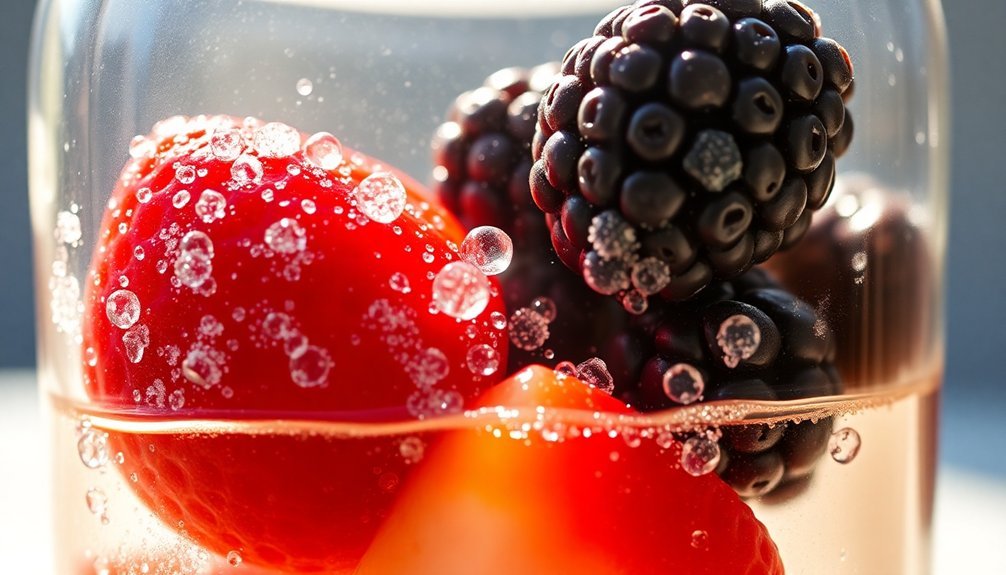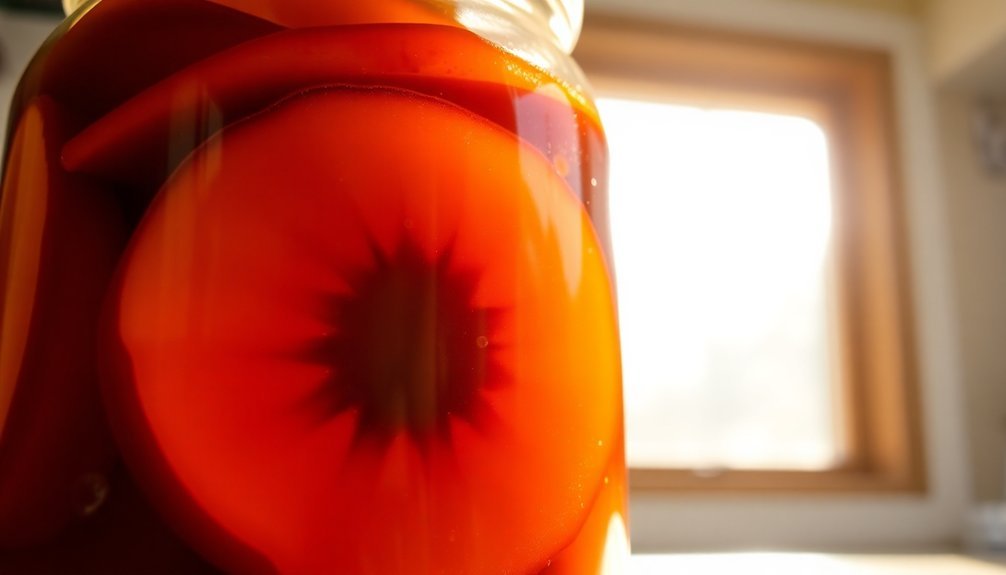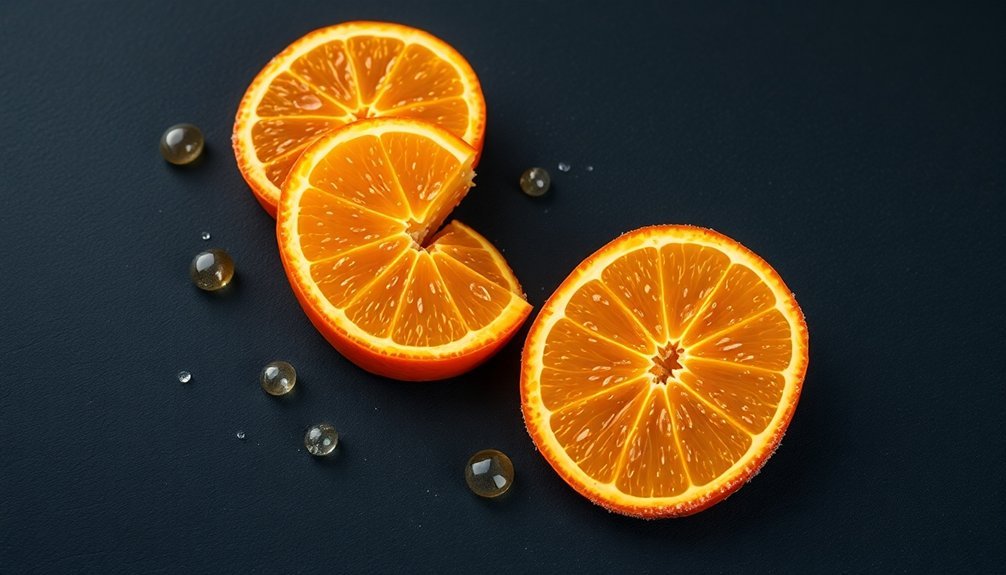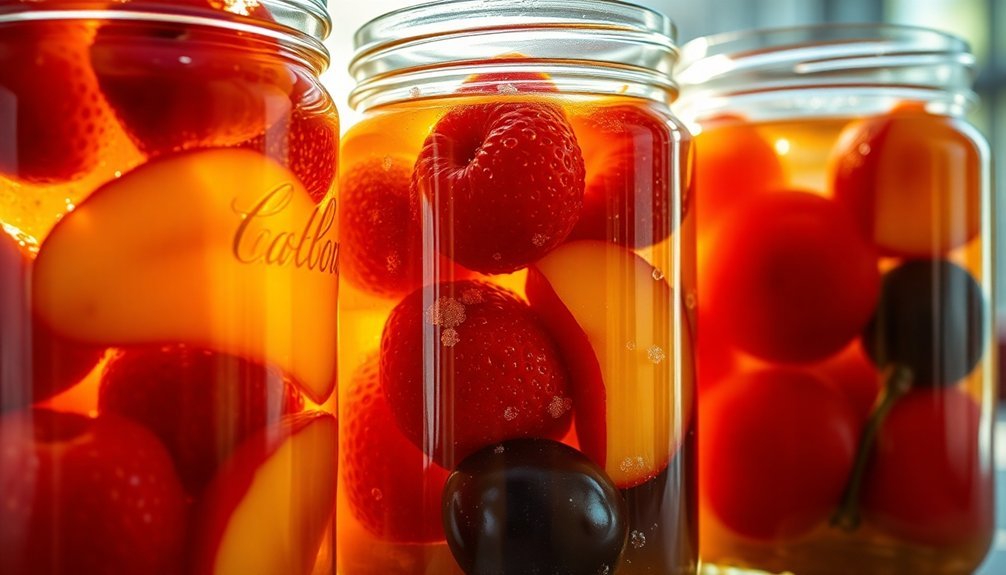The 7 best sugar osmosis preservation methods will help you keep your food fresh longer. You'll find success with traditional fruit sugar syrup, which works great for jams and preserves at 221°F. Try honey crystallization storage in airtight containers, or explore sugar fermentation using beneficial bacteria. High-density sugar packing creates an inhospitable environment for microbes, while molasses preservation works well in cool, dark spaces. Sugar brine pickling combines salt and sugar for effective preservation, and candied fruit methods excel at long-term storage. These time-tested techniques reveal just the beginning of sugar's remarkable preservation power.
Traditional Fruit Sugar Syrup Method

You'll know your preserves are ready when they reach 221°F (105°C) or pass the frozen plate test.
Layering your fruit with sugar and allowing it to sit for 1-3 days helps develop richer flavors through maceration.
For storage, you've got two options: refrigerate for immediate use or process in a water bath for long-term preservation.
If you're canning, make certain you're using sterilized jars and proper sealing techniques.
Your finished preserves will keep for at least a year when stored in a cool, dark place.
Honey Crystallization Storage Technique
When you store honey properly between 50-70°F in tightly sealed glass containers, you'll maximize its natural antimicrobial properties that prevent spoilage.
You can control moisture levels by keeping the container upside down and away from direct sunlight, which helps maintain honey's high sugar concentration and osmotic pressure. Plastic containers can speed up the crystallization process compared to glass jars.
You'll benefit from honey's indefinite shelf life when you avoid refrigeration and use proper sealing techniques, as these practices prevent crystallization and maintain the food's preservative qualities.
Natural Antimicrobial Properties
Through its remarkable composition, honey stands as nature's most effective sugar-based preservative, combining multiple antimicrobial mechanisms to protect foods from spoilage. When you use honey as a preservative, you're harnessing its high sugar concentration, which creates an osmotic effect that draws water out of harmful microorganisms, effectively dehydrating and killing them.
You'll find that honey's effectiveness goes beyond simple sugar concentration. Its natural enzyme glucose oxidase produces hydrogen peroxide, while its acidic pH (3.2-4.5) creates an environment where most harmful bacteria can't survive. Ancient Egyptian tombs contained wholesome honey deposits that remained preserved for thousands of years.
Unlike other sugar-based preservatives, honey's unique combination of properties makes it particularly effective against pathogens like Salmonella.
To maximize honey's antimicrobial benefits, you'll need to store it properly. Keep it in tightly sealed glass containers at room temperature, away from heat sources and direct sunlight.
While crystallization may occur naturally, it won't affect honey's preservative properties. If your honey crystallizes, you can gently warm it in a water bath to restore its liquid state.
Remember that honey's preservative power markedly outperforms other sugars, making it an ideal choice for natural food preservation.
Moisture Control Process
Building on honey's natural preservative powers, proper storage techniques play a central role in maintaining its antimicrobial effectiveness. You'll want to focus on controlling moisture levels, as this directly impacts honey's preservation capabilities.
Store your honey in airtight glass containers with tight-fitting lids, as glass offers superior protection against moisture compared to plastic or metal containers.
To minimize moisture absorption, you'll need to keep your honey in a cool, dark pantry or cupboard at temperatures between 70°F and 80°F (21°C to 27°C). Don't store honey below 50°F (10°C), as cold temperatures speed up crystallization. An effective technique is storing containers upside down, which creates a natural barrier against air and moisture infiltration.
You should avoid direct sunlight and heat sources, as they can compromise honey's quality and affect its moisture content. Additionally, maintaining consistent storage conditions is essential – fluctuations in temperature or humidity can trigger crystallization.
Long-Term Storage Benefits
Understanding honey's crystallization process can help you maximize its long-term storage potential.
You'll want to maintain temperatures between 50°F and 70°F for short-term storage, while temperatures below 41°F work best for long-term preservation of flavor and texture.
Don't store your honey in the refrigerator, as cold temperatures speed up crystallization.
When selecting containers, opt for glass jars with tight-fitting lids or plastic containers that seal well.
You'll need to avoid metal containers since they can trigger crystallization.
To further protect your honey, store containers upside down to prevent air from entering, and always guarantee the lid is properly sealed after each use.
Keep your honey in a cool, dark place like a pantry or cupboard.
You'll want to avoid direct sunlight, which can cause darkening, flavor loss, and accelerated crystallization.
If you notice crystals forming, you can dissolve them by carefully heating the honey in a water bath or microwave.
Remember to use hot mitts when handling heated containers.
With proper temperature control, container selection, and protection from light, you'll maintain your honey's quality for extended periods.
Sugar Fermentation Process

You'll find that sugar fermentation relies heavily on yeast's ability to convert sugars into alcohol while creating natural preservative compounds.
By controlling the sugar-to-salt ratio in your ferments, you can direct the preservation process and encourage beneficial bacteria growth.
The natural acids that develop during fermentation help create an inhospitable environment for harmful bacteria, making your preserved foods both safe and flavorful.
Yeast Conversion To Alcohol
While many people enjoy fermented products like wine and beer, few understand the fascinating process of yeast converting sugar into alcohol. When you're looking at yeast fermentation, you'll find that Saccharomyces cerevisiae plays an essential role by breaking down sugars through glycolysis. This process converts glucose into pyruvate molecules, generating ATP and NADH along the way.
You'll notice that yeast cells prefer glucose over other sugars, metabolizing it first before moving on to fructose. The conversion process works best when temperatures stay between 5°C and 35°C.
During fermentation, pyruvate decarboxylase converts pyruvate into acetaldehyde and CO2, followed by alcohol dehydrogenase turning acetaldehyde into ethanol. The chemical equation shows you that one glucose molecule (C6H12O6) ultimately produces two ethanol molecules (C2H5OH) and two CO2 molecules.
For successful fermentation, you'll need to provide yeast with proper nutrients and ideal conditions. Beyond alcohol production, this process creates various compounds that contribute to the flavor and aroma of your fermented products, including glycerol and acetic acid.
Natural Acid Development
Lactic acid bacteria work tirelessly as nature's food preservers, converting sugars into acids through fermentation. Through this process, you'll find these helpful microorganisms transforming sugars into lactic acid and carbon dioxide, naturally lowering the pH of your food while creating that distinctive tangy flavor you recognize in foods like kimchi, sauerkraut, and yogurt.
You can observe this preservation method in action as sugars break down into pyruvic acid during glycolysis. Without oxygen present, the pyruvic acid converts to lactate, creating an environment that's hostile to unwanted bacteria. This natural process doesn't just preserve your food – it enhances its flavor and nutritional value.
When you're fermenting foods, the lactic acid reduces water activity and creates an acidic environment that harmful bacteria, like Clostridium botulinum, can't survive in.
You'll find this method at work in various foods you might already enjoy, from sourdough bread to kombucha. The carbon dioxide produced during fermentation also contributes to the characteristic fizzy texture you'll notice in some fermented beverages, making this preservation technique both effective and versatile.
Sugar-Salt Balance Control
Through precise control of sugar and salt concentrations, you can create an environment that effectively preserves food while maintaining its quality. When you combine these two preservatives in the right proportions, you'll create conditions that inhibit microbial growth and extend shelf life.
The key is understanding how sugar and salt work together to achieve ideal preservation results. You'll need to follow research-tested recipes carefully, as the balance between sugar and salt is essential for food safety.
In products like jams and jellies, you'll find that sugar interacts with natural pectin and acids, creating a preservation system that slows bacterial growth. When you're canning or freezing foods, the combination helps preserve not only safety but also color, texture, and flavor.
The preservation method works because sugar binds to water molecules, reducing water activity below the 0.90 threshold that most microorganisms need for growth. Meanwhile, salt creates additional osmotic pressure, forcing water out of microbial cells.
High-Density Sugar Packing
Three key mechanisms make high-density sugar packing an effective food preservation method.
First, sugar absorbs water from food, reducing water activity.
Second, it creates an osmotic effect that draws water out of microbial cells.
Third, it disrupts microbial metabolism, making the environment hostile to bacteria, yeasts, and molds.
You'll find this preservation technique widely used in jams, jellies, and pickles, where high sugar concentrations prevent microbial growth.
When you're preparing jams, you'll typically use equal amounts of sugar and fruit pulp, preferably selecting under-ripe fruits with high pectin content for better preservation.
You can apply this method by packing fruits and vegetables in crystalline sugar or high-density sugar liquids like honey.
Ancient civilizations recognized honey's preservative properties, and today you'll still find it's an effective natural preservative.
While this method saves energy by eliminating the need for refrigeration, you'll need to verify proper storage to maintain shelf life.
Keep in mind that sugar alternatives may not work as effectively due to their different chemical makeup, and some yeasts and molds can still resist high osmotic pressure.
Molasses Preservation System

Building on sugar's preservative properties, molasses offers a unique preservation system that requires specific storage conditions and handling techniques.
You'll need to store unopened jars in a cool, dry, dark location, where they can last up to a year. If you're in a warm climate, refrigeration can help maintain consistent temperature, though you'll need to warm the molasses before use to reduce its thickness.
To prevent spoilage, you'll want to keep your molasses in its original container and clean the lip before sealing it after each use.
Watch for warning signs like mold, which can appear as a subtle slick or fuzzy patches. If you spot even the smallest amount of mold, you must discard the entire jar. Other red flags include off-smells, stained patches, separation, or crystallization.
You can enhance molasses preservation using specialized enzymatic formulations that protect total reducing sugars and control bacterial growth.
These enzymes prevent organic acid formation and can maintain stability for up to six months. While biocides are an alternative, they're not as effective as enzymatic treatments in preventing degradation.
Sugar Brine Pickling
Sugar brine pickling combines precise measurements of sugar and salt to create a powerful preservation solution that draws moisture from foods through osmosis.
When you create this brine, you're establishing an environment where harmful bacteria can't survive, while beneficial bacteria can thrive during fermentation.
You'll need to start with extremely fresh ingredients and prepare them properly – either by slicing or leaving them whole.
Your brine solution requires careful attention: boil water with the correct ratio of sugar and salt, then add any desired spices.
You can choose between two main methods: traditional fermented pickling, which takes several weeks, or quick-process pickling using hot vinegar with 5% acidity.
Whether you're pickling cucumbers, peppers, or fruits, you'll need to guarantee proper storage conditions.
Store your finished pickles in a cool, dark place after heat processing and proper sealing.
You'll know your pickles are safe when they're free from cloudiness, discoloration, or mold.
For the best flavor development, let your pickles age for about eight weeks before eating.
When done correctly, your sugar-brined pickles can last up to a year or more.
Candied Fruit Preservation

While sugar brine pickling relies on osmosis to preserve foods in liquid, candied fruit preservation takes a different approach by infusing fruits directly with sugar syrup.
You'll need to decide whether to store your candied fruit in syrup or dry it completely, as each method offers distinct advantages for different uses.
If you're storing in syrup, place your candied fruit in an airtight container, filling it to the top to minimize air space. Keep it refrigerated and always use clean utensils when removing pieces to prevent contamination. This method will preserve your fruit for at least 4 months.
For dried storage, you can use a food dehydrator or air-dry at room temperature until the fruit becomes tacky. Once dried, store in an airtight container at cool room temperature. This method works best when you're planning to use the fruit in recipes that can't handle extra moisture.
For maximum longevity, you can freeze candied fruit for up to two years. Store it in freezer-safe containers, removing as much air as possible.
Whatever storage method you choose, maintain temperatures between 60-70°F and keep the fruit in dark, airtight containers away from strong odors and heat sources.
Frequently Asked Questions
Can Sugar-Preserved Foods Be Safely Consumed by Diabetics?
You shouldn't regularly consume sugar-preserved foods if you're diabetic, as they'll considerably impact your blood sugar levels. It's better to choose alternative preservation methods or low-sugar options for your dietary needs.
How Does Altitude Affect Sugar Preservation Methods?
At higher altitudes, you'll need to adjust your heat processing times, but sugar's osmotic preservation effect stays constant. While altitude won't directly impact sugar's preserving power, you should monitor moisture loss more carefully.
Why Do Some Preserved Fruits Float While Others Sink?
You'll find that preserved fruits float or sink based on their original density compared to water. If they're less dense than water, they'll float; if they're denser, they'll sink, following Archimedes' Principle.
Does Artificial Lighting Impact the Quality of Sugar-Preserved Foods?
While artificial lighting won't affect your food's preservation process or safety, it can fade colors and impact appearance over time. You'll want to store sugar-preserved foods in low-light conditions to maintain their quality.
Can Sugar-Preserved Foods Be Safely Frozen for Longer Storage?
Yes, you can safely freeze sugar-preserved foods. You'll need to use airtight containers and maintain a temperature of 0°F (-18°C). Sugar actually helps protect the texture and quality during freezing.
In Summary
By using these seven sugar osmosis methods, you'll extend your food's shelf life naturally and safely. Whether you're working with fruit syrups, honey crystallization, or sugar fermentation, you're tapping into time-tested preservation techniques. You can easily adapt these methods to suit different foods and storage needs. Start with simple processes like sugar brine pickling, then work your way up to more complex techniques like molasses preservation.





Leave a Reply